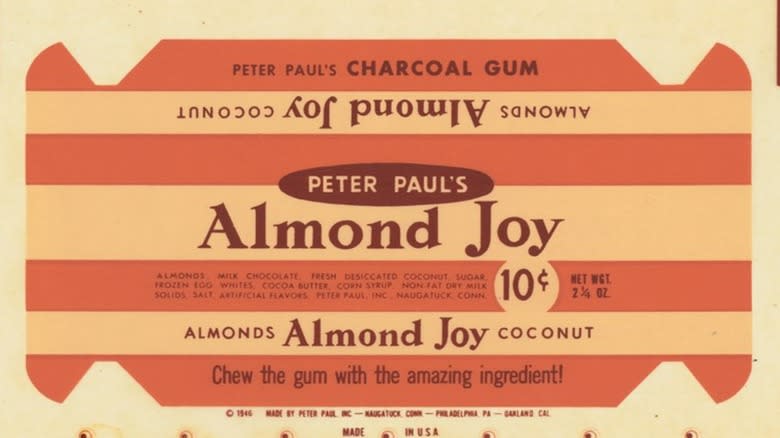You Probably Wouldn't Recognize Almond Joy's Original Wrapper

The Almond Joy, which is essentially a slab of shredded coconut topped with a couple of almonds and coated in chocolate, has been around since the 1940s. It came along a few decades later than its non-nutty rival, the Mounds bar, which was invented in 1920, and Almond Joy has been a regular fixture in the candy aisle ever since. Because of its heavy use of coconut, it hasn't always been universally enjoyed, but it has defenders like Valerie Bertinelli fighting in its corner nonetheless.
It's fairly easy to spot an Almond Joy in stores, particularly because the branding hasn't really changed over the years in terms of the color scheme -- these candy bars have been rocking blue and white wrappers for as long as most people can remember. If you're familiar with a modern Almond Joy, though, you probably won't recognize the orange-and-beige-striped packaging of Almond Joy's original wrapper.
Dating back to 1946, this design has a pleasant, sweet-shop-paper-bag vibe. It even contains an advertisement for Peter Paul's Charcoal Gum, "the gum with the amazing ingredient!" referencing a 1940s product purported to whiten your teeth and freshen your breath.
Read more: 13 Store-Bought Ice Cream Bars Ranked From Worst To Best
How The 1946 Almond Joy Wrapper Compares To Today's

We can learn a lot about how the candy bar has changed over the years by examining Almond Joy's original packaging -- just look at the size difference! Close examination of the wrapper shows that the original chocolate bar was an impressive 2 ¼ ounces, which makes the bar's current size of 1.61 ounces seem more like a sample than a substantial treat. This may be due to rising manufacturing costs (also cited by Mars as the reason Twix bars are getting smaller), but it still hurts a little bit.
The price difference seems like a kick in the teeth as well; it's hard to imagine anything costing 10 cents these days. 10 cents in 1946 is worth $1.64 now, which means Walmart's current online price of $1.17 is actually cheaper. You still get less chocolate, though, so is it truly a win? The fact that the price is printed on the wrapper at all is noteworthy, as that's not something we've come to expect with candy bars today, since pricing varies depending on where you purchase the bar.
We've come a long way from the days when Mounds bars were hand-dipped and individually wrapped in foil, through the early years of Almond Joy's quaint pastel stripes and the funky blue and white stripes it sported in the '70s, to the cheerful bubble letters on today's wrapper. But it's nice to know there's always somewhere to turn when you feel like a nut.
Read the original article on Mashed.

